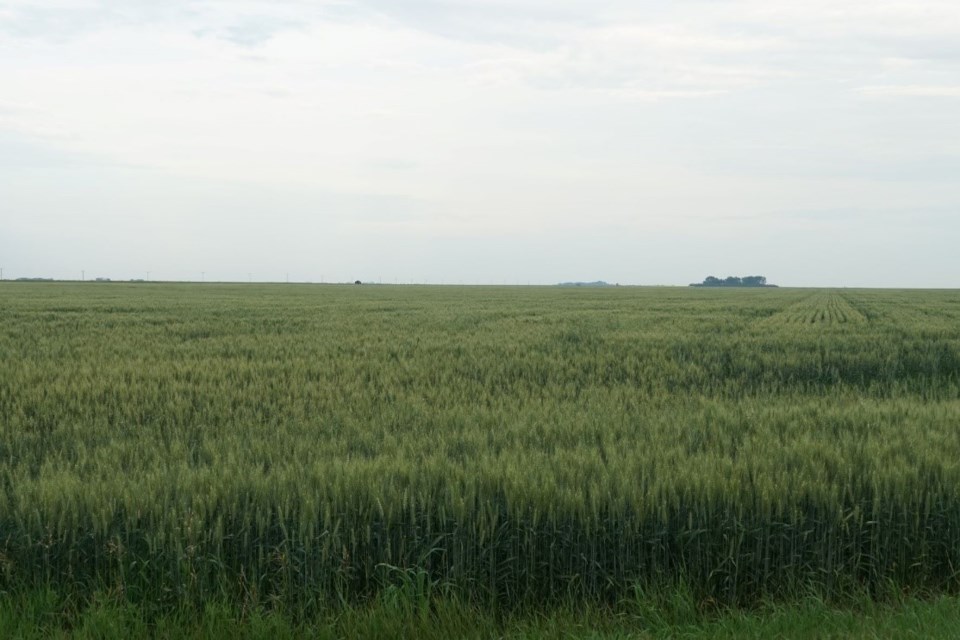The extended period of hot and dry weather conditions during the June 29 to July 5 period has taken a toll on many crops in the northeastern region.
Yield potential has already been impacted with many crops showing symptoms of heat stress. Some crops are thin and stunted and are prematurely advancing and drying down. However, some areas of the region are reporting that the crops remain in good shape but will need rain soon to help them further develop and fill.
Very little rainfall was received last week, ranging from trace amounts to 21 mm in the Porcupine Plain area. The Humboldt, Garrick and Vonda areas reported 1 mm of rain while the Tisdale, Birch Hills and Arborfield areas reported 2 mm.
Topsoil moisture conditions have severely declined in the region and significant rain is needed soon to replenish the topsoil and allow for crops to fill. Crop land topsoil moisture is rated as zero per cent surplus, 20 per cent adequate, 53 per cent short and 27 per cent very short. Hay and pasture land topsoil moisture is rated as zero per cent surplus, 20 per cent adequate, 51 per cent short and 29 per cent very short. Crop District 8A is reporting that 38 per cent of the cropland and 45 per cent of the hay land and pasture is very short topsoil moisture at this time.
Haying progress is the most advanced in the province with 31 per cent of the hay crop cut and 11 per cent baled or put into silage. Hay quality is rated as 10 per cent excellent, 60 per cent good and 30 per cent fair. Yields at this time are expected to be lower than normal, although some wetter areas are hoping for average yields. Pasture conditions are worsening due to the lack of moisture and hot temperatures and are currently rated as two per cent excellent, 15 per cent good, 30 per cent fair, 42 per cent poor and 11 per cent very poor.
The majority of crop damage this past week is due to lack of moisture, strong winds, gophers and insects such as grasshoppers.
Farmers are busy haying, fixing equipment, applying fungicides if warranted and hoping for rain.
The Northeastern crop report, provided by the provincial government, covers Hudson Bay, Tisdale, Melfort, Carrot River, Humboldt, Kinistino, Cudworth, Aberdeen, Prince Albert, Choiceland and Paddockwood areas.
Ìý
East Central Saskatchewan
Like the majority of the province, the extended period of hot and dry weather has caused significant damage to crops in the east-central region. Crops such as canola that were flowering during the heat wave will be the most impacted, as heat blasting and heat stress symptoms are showing up in many fields. In some fields, there may be irreparable damage to yield potential as crops are quickly advancing. Many crops are thin, stunted and uneven with some prematurely ripening. Significant moisture is needed soon to replenish the topsoil moisture and to allow crops to properly fill.ÌýÌý
While most of the region received small amounts of rain, the Wynyard area reported 21 mm, the Bulyea area 12 mm, the Kenaston area 10 mm, the Pelly area 4 mm, the Kelvington area 11 mm, the Lipton area 1 mm, the Kelliher area 5 mm, the Langenburg area 2 mm and the Allan area 3 mm.
Topsoil moisture conditions have sharply deteriorated across much of the region. Cropland topsoil moisture is rated as zero per cent surplus, 17 per cent adequate, 58 per cent short and 25 per cent very short. Hay and pasture land topsoil moisture is rated as zero per cent surplus, 10 per cent adequate, 45 per cent short and 45 per cent very short. Crop District 6A is reporting that 35 per cent of the cropland and 67 per cent of the hay land and pasture is very short topsoil moisture at this time.
Haying continues with 15 per cent of the hay crop cut and 12 per cent baled or put into silage. Hay quality is rated as four per cent excellent, 62 per cent good, 23 per cent fair and 11 per cent poor. Yields are expected to be much less than normal, especially in those areas that did not receive large amounts of rain this spring. Pastures already have reduced carrying capacity and many water sources have already dried up. Pasture conditions are currently rated as one per cent excellent, 12 per cent good, 28 per cent fair, 49 per cent poor and 10 per cent very poor.Ìý
The majority of crop damage this past week is due to lack of moisture, strong winds, gophers and insects such as grasshoppers.
Farmers are busy haying, applying fungicides if warranted, fixing equipment and hoping for rain.
The East Central crop report, provided by the provincial government, covers Watrous, Melville, Yorkton, Cupar, Kamsack, Foam Lake, Preeceville, Kelvington, Lumsden, Craik and Clavet areas




